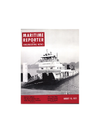
New Engine Room Simulator To Improve Supertanker Training
A computer-based simulator for training engine room officers of supertankers will go into operation early in 1978 under a development contract signed between the Organization for Industrial Research TNO, a Dutch corporation, and Esso Tankvaart Maatschappij B.V., an affiliate of Esso Nederland B.V.
The unique engine room simulator will be located at the TNO Institute for Mechanical Constructions in Delft, Netherlands. It will be the first of its kind in Europe and will have extensive training exercises for both normal and emergency operations. The European locations will be convenient for the training of officers joining or leaving their ships.
The facility will accurately simulate the appearance and behavior of the main consoles and electrical power panels with which marine engineers work in the engine control room of a typical very large crude carrier (VLCC).
In an adjoining room, graphic displays of key systems will allow trainees to gather information and respond to events as they would in the machinery space outside the engine control room of a VLCC.
The engine room simulator will complement the TNO Ship Bridge Simulator activities in Delft at which Exxon, of which Esso Nederland is an affiliate, has trained nearly 500 tanker deck officers and pilots over the last six years.
Between 80 and 100 junior and senior engine officers a year from Exxon's worldwide fleets are scheduled to be trained in the simulated engine room when it becomes operational.
The facility will be offered by TNO to engine officers from other companies on a space-available basis, in a similar manner to the Bridge Simulator. The engine room simulator will also be available for research and development purposes.
The courses for engine room officers will last five days and will involve classroom instruction and hands-on use of the simulator.
Simultaneous translation of instruction will be available in English, Italian, Dutch, Spanish, French, German, Korean, and other languages to reflect the international makeup of VLCC crews.
The simulator will be used to expose the officers to a large number of normal and emergency circumstances, providing the equivalent of years of experience in a short period of time. It will train the officers to recognize and react quickly and correctly in crisis situations.
The computer allows the facility to simulate a large number of exercises including: Emergency situations during startup, maneuvering and normal steaming; Complex operations such as starting up the powerplant from a cold condition; Practice on specific tasks such as paralleling generators and testing main engine controls.
In addition, the simulator will be used to instruct officers in the various techniques of saving fuel, a matter of increasing importance in proper engine room control.
The purpose of the Netherlands TNO Organization for Industrial Research is to coordinate and to further the development and application of technological improvements for practical use.
The computer program and specialized hardware for the simulator were developed over the last two years by Exxon International and Exxon Research and Engineering at a cost of over a half million dollars. The site, computer and interfaces, and the necessary operations expertise are TNO's contribution to the facility.
Other stories from August 15, 1977 issue
Content
- U Of Michigan Adds Naval Architecture- Engineering Facilities page: 4
- Micro Line Systems Apply For Title XI For Ro/Ro Containerships page: 7
- Newest Addition To ACBL Towboat Fleet Named For Texas Gas Transmission President page: 10
- Paul-Munroe Acquires Rucker Marine Systems page: 10
- Flume Stabilization Names Peter Maschke page: 10
- Liaison With Maritime Industry Subject Of Stevens Tech Meeting page: 12
- Hydra lift Skegs page: 14
- Northwest Marine Receives Major Navy Contract page: 16
- Genstar To Purchase Gulf Of Georgia Towing page: 16
- James Dunford Named CDI Vice President page: 17
- Prudential Lines Names Karl Eckhardt VP And General Manager page: 18
- Inert Gas Systems Fitted Aboard Tankers Building At NASSCO page: 20
- Rohr Industries Names Filiciotto And Walsh page: 20
- Hyundai Mipo Dockyard Converting Two Bulkers Into Ro/Ro Ships page: 21
- Biehl & Company Announces Managerial Promotions In Houston page: 21
- Airfilco Engineering Names John E. Riley VP And Gen'l Manager page: 22
- Three-Day Weather Conference And Exhibit page: 22
- GT&T Announces Management Changes page: 23
- Pott Industries Inc. Becomes HNG Subsidiary page: 24
- Steamco II, Inc. Opens Office In Jacksonville —Whitney Appointed page: 25
- Underwater Acoustic Explorations At The University Of Rhode Island page: 29
- N.C.S. Of Cairo, Egypt Appoints Pouch Terminal page: 29
- McMullen Assoc. Opens Hampton Roads Office —Joseph Bunting Named page: 30
- Charles Hurd Joins Southwest Marine, Inc. page: 30
- Seaworthy Appoints Patrick J. McAllister page: 31
- Prudential Agrees To Sell South American Shipping Operations page: 31
- ABS Forms 18-Member Hong Kong Technical Committee page: 36
- Great Lakes Steamship Division Of Bethlehem Appoints Roy Dobson page: 38
- Edo Western Corp. New Deep Tow Survey System page: 38
- James Moseley Heads Port Of Jacksonville Propeller Club page: 44
- Carter Group Sees Zapata Rig At Work page: 45
- First International Symposium On Computer Aided Hull-Surface Definition page: 46
- Diving And Insurance Symposium Scheduled Nov. 14-15 In New York page: 46
- Equitable Shipyards, Inc. Ships Last Two In Series Of Five 95-Foot Tugs To Indonesia page: 49
- Electro-Nav's Fifth Annual Navigation And Communications Exhibit Held In New York page: 49
- Butterworth Systems Relocates Headquarters page: 50
- New Engine Room Simulator To Improve Supertanker Training page: 52
- Ohio River Company Towboat M / V Queen City Receives Nation's Highest Safety Award page: 53
- E.R. Remkes Named President Of C-E Crest, Tulsa Engineering Firm page: 53
- Proceedings Of First N.Y. Port Com-Nav Conference Now On Sale page: 54

